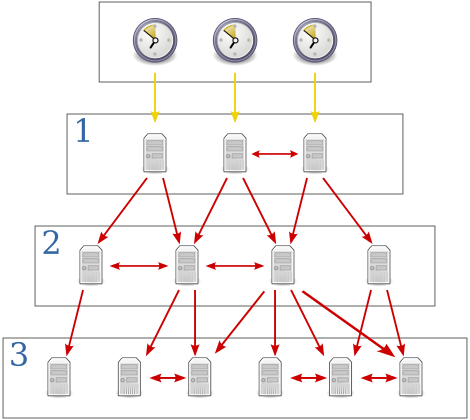As part of my last post, I was exploring video transcoding with an Intel Arc GPU and how different levels of ICQ affect video size and quality. During which, I noticed there’s a QSV compatible filter in ffmpeg called vpp_qsv which has a detail parameter. VPP stands for Video Post Processing and the filter help text simply says “enhancement level” for detail. The potential to do some automatic picture enhancements directly on the GPU piqued my interest so I decided to have a play with it.
Transcoding with an Intel Arc GPU
I am a bit of an NVIDIA fanboy when it comes to GPUs. This is partly down to being a long time Linux Desktop user (until recently) and them having excellent drivers allowing me to pretty effortlessly get proper hardware acceleration working.
In my lab environment I have an old Nvidia Quadro P400 that’s set up for various transcoding workloads and its been working absolutely great for me despite being an older card. I have been primarily using the h264 codec but I recently moved over to h265 (hevc) mostly out of curiosity, and to see if I could get quality on-par with h264, whilst getting similar file sizes.
A Stratum 1 Time Server – The Basics
A while ago, I decided to play around with trying to create something cheap that would be able to synchronise its time by using GPS instead of over the internet – essentially building my own Stratum 1 time server. I intend this to be a series of articles about NTP and time servers, but let’s start with the basics…
What is a Stratum 1 Time Server?
 The lower the “Stratum” number the more accurate the time it should be able to tell. Usually Stratum 1 time servers are directly connected to an accurate source of time such as (but not limited to) Atomic, GPS or even Radio clocks. The stratum of the machine which itself is directly interfacing with the accurate time source would be “Stratum 0”. For each additional layer of NTP servers added, the stratum increases by 1.
The lower the “Stratum” number the more accurate the time it should be able to tell. Usually Stratum 1 time servers are directly connected to an accurate source of time such as (but not limited to) Atomic, GPS or even Radio clocks. The stratum of the machine which itself is directly interfacing with the accurate time source would be “Stratum 0”. For each additional layer of NTP servers added, the stratum increases by 1.
So if the server that’s connected directly to the time source is stratum 0, it would appear to any clients who want to synchronise with it as a stratum 1 source. If someone then tries to synchronise to one of those, they would see a stratum 2 source and so on. The image on the right illustrates the top-down increase in stratum and was taken from Wikipedia.
Generally the higher the stratum number, the less-accurate its view of time is. A stratum ranges from stratum 1 all the way to stratum 15 indicating the time is getting further away from a reference clock the higher you go. Stratum 16 indicates the clock is pretty far from the reference and should be considered un-synchronised and should not be used.
Ubiquiti EdgeRouter IPsec performance
 I’ve been working on setting up a lab environment for myself and decided to pick up a couple of Ubiquiti’s EdgeRouter 4 routers to act as my core routing devices, along with an EdgeRouter X to act as my out-of-band router. These new devices, along with an EdgeRouter Lite loaned to me for this article by Dom at LoveServers, puts me in a reasonably good position to do some performance testing between these different models of EdgeMAX routers. I thought a good place to start would be to compare how well these different models perform in terms of IPsec throughput and overall CPU usage at the same time.
I’ve been working on setting up a lab environment for myself and decided to pick up a couple of Ubiquiti’s EdgeRouter 4 routers to act as my core routing devices, along with an EdgeRouter X to act as my out-of-band router. These new devices, along with an EdgeRouter Lite loaned to me for this article by Dom at LoveServers, puts me in a reasonably good position to do some performance testing between these different models of EdgeMAX routers. I thought a good place to start would be to compare how well these different models perform in terms of IPsec throughput and overall CPU usage at the same time.
Part of my lab setup will involve provisioning a couple of IPsec tunnels between the lab and my home network. So whilst this article will mainly focus on IPsec, I will be including some general observations/comparisons between the devices too which may be informative to some people. Read More
Ethereum Mining with NVIDIA on Linux
![]() Bitcoin has been getting a lot of attention in the media lately; primarily due to its association with recent high profile ransomware incidents. Bitcoin was first introduced back in 2009 as a digital currency and has been steadily gaining traction since, increasing almost 140% in value so far this year!
Bitcoin has been getting a lot of attention in the media lately; primarily due to its association with recent high profile ransomware incidents. Bitcoin was first introduced back in 2009 as a digital currency and has been steadily gaining traction since, increasing almost 140% in value so far this year!
Bitcoin however, is not the only player in the game; Ethereum is another popular digital currency, currently sitting at 2nd place in total market value and is getting a lot of activity on currency exchanges.
An incentive to help keep the underlying “network” up and running (for both Ethereum and Bitcoin, amongst others) is a piece of software which can be used to validate transactions on the network and issue rewards for doing so. This is otherwise known as Mining.
My current Gaming PC seems to grab me a reasonable amount of Ethereum Tokens on 2+ year old hardware. Certainly enough to make me want to play around with actually mining some.
PHP Handlers and PHP 5 vs 7
 The idea for this post actually came from observing performance after moving this site over to WordPress (and to a lesser extent, my other website, General Photography). I use Puppet orchestration for my servers and I made the mistake of trying to convert everything to puppet manifests and also get things working how I wanted without fully understanding how puppet works at the same time; That however is another story. This does means that my puppet manifests are not very flexible currently and I use suphp as my main PHP handler just because for me, at the time, it was easier.
The idea for this post actually came from observing performance after moving this site over to WordPress (and to a lesser extent, my other website, General Photography). I use Puppet orchestration for my servers and I made the mistake of trying to convert everything to puppet manifests and also get things working how I wanted without fully understanding how puppet works at the same time; That however is another story. This does means that my puppet manifests are not very flexible currently and I use suphp as my main PHP handler just because for me, at the time, it was easier.
That being said – I’m fully aware of the performance issues suphp exhibits because my Observium install used it at first – it now uses mod_php because loading all the graphs was noticably slow. I thought I’d try to quantify the performance differences between suphp and mod_php and decided I should do all 3 common PHP handlers. Whilst I was gathering metrics for this I decided It’d be useful to include PHP7 results too. Read More
